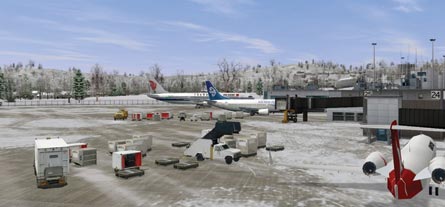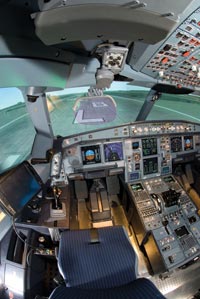While the development of three-axis control surfaces and a reliable petrol engine were essential to the Wright brothers' first flight and dawn of practical aviation, economical and safe modern aircraft operations owe much to the development of flight simulation devices.
Realistic flight simulators allow aircrew to be trained in a low-cost - relative to the real aircraft - controlled environment. Additionally, simulation allows for the practice of emergency procedures and manoeuvres, until proficiency is attained, in a safe environment.
|
|---|
The three main elements of a visual system are its database, image generation capability and display/projection. On the database front, advancements in satellite imaging have allowed for the deployment of landscapes outside the immediate airport environment with a resolution of at least 64m (210ft), and down to 15m in some instances. On the airport itself, US Federal Aviation Administration Part 60 regulations require airport depictions to reflect actual airport conditions. Using CAE's True Airport product, users' airport databases can be easily updated to reflect the latest Jeppesen and Aeronautical Information Publication (AIP) data.
Image generation is another area where technological advancements enhance the visual system. Until the turn of the century, simulator visual systems used expensive proprietary graphics generators. In the 1990s CAE's Maxvue 2000 system was state of the art, with an image generation capability of 1,000 polygons at 60Hz. Computer gaming requirements have led to the development of graphics processors that can generate over 100,000 polygons at 60Hz, however. These commercial off the shelf components by makers such as ATI and NVIDIA are 1,000 times more powerful and cost a fraction of their proprietary predecessors. For its Tropos-6000 system, CAE uses NVIDIA's GeForce GTX 280 processor.
Just as plasma and LCD displays have displaced cathode ray tube-based televisions, simulator display systems have undergone a similar transition. Heavy CRT projectors that once sat on top of the simulator cab, drawing lots of power and generating excess heat, have been replaced by liquid crystal technology. LCoS (liquid crystal on silicon) projectors offer light weight and reduced power consumption. Additionally, CAE has developed its "Autocal" automated calibration system. Autocal can be remotely operated and significantly reduces the time needed to calibrate the visual display.
While visual cues are an essential part of piloting and its simulation, tactile cues also play a significant role. Until recently full motion simulators were primarily actuated by hydraulic systems.
In co-operation with Moog, CAE has developed its True electric motion system. Capable of supporting cabs weighing 14,515kg (32,000lb), the all-electric system promises to be much greener than a hydraulic unit. No toxic hydraulic fluid is needed and the quiet electronic system draws less than one quarter the power of a comparable hydraulic system.
CAE is not alone in making advancements in motion drive technology. Other manufacturers including Mechtronix, a Montreal-based simulator company, also offer electronic motion system for their full-motion simulators.
VISUALLY BETTER
The preview CAE 7000 simulator was an Airbus A330-200 with Rolls-Royce Trent engines. The Level D device featured a nominal 200 x 40e_SDgr field of view Tropos-6000 visual system. As with most other CAE products, the simulator's cockpit was built primarily with OEM parts, adding to the feel of authenticity.
|
|---|
During the taxi to Runway 7L for take-off, the simulator operator varied the surface roughness from smooth, level 0, to very rough, level 5. The rougher taxiway surface setting served to give a little tactile "texture" to the simulation experience.
A maximum power take-off was executed, the thrust levers being placed in the take-off go-around detent. Simulator motion complemented peripheral visual cues to give the sensation of acceleration. Once airborne, with gear and flaps retracted, I turned the A330 towards the west.
During the manoeuvring I found the visual display to be quite good, with the many surrounding islands appearing to be fairly realistic. Moving my head to change my visual reference point showed little distortion in the simulators visual display field. The large visual field of view also afforded many peripheral cues, further aiding visual manoeuvring.
The Tropos-6000's powerful graphics generators also allow for a more realistic depiction of clouds and weather conditions. Clouds are shown with feathered and varied edges. Cloud base and top contours are also varied, making the ceiling appear more realistic. The scene generation capability is so great that cloud's shadows are cast on the surface.
The simulator operator next repositioned the A330 to a 15km (8nm) final for an instrument landing system approach to Runway 7L. While the aircraft was being repositioned, the white light in the centre windscreen pillar mounted seat alignment spheres flashed. Once the simulator was ready to resume flight in its new location, the flashing stopped.
While this may appear to be a small thing, it will undoubtedly make the simulator instructor's job easier. During the hand-flown ILS approach I found the simulator a bit sensitive in roll. I have never flown an actual A330 and I cannot say the simulator did not accurately represent the aircraft. What I have found, however, is that making a simulator feel right in the roll axis is a challenging task.
After the full stop landing from the approach to the airport, the simulator was repositioned to Beijing. For the take-off from Beijing's Runway 36L, dusk lighting and winter conditions were selected. Light snow accumulation was depicted on the ground and runway surfaces. A 14kt (26km/h) wind from the west blew snow across the runway, graphically showing the left crosswind.
During the take-off roll, large individual snow flakes were also shown approaching the aircraft, enhancing the feeling of speed as we accelerated towards lift-off. At the V1 indicated airspeed of 145kt, to my surprise, the left engine was failed. The resulting yawing motion was easily picked up by reference to the visual scene.
Simulator motion also emphasised the yawing motion, further facilitating recognition of the engine failure. Once airborne, as with my flights in actual Airbus aircraft, I found the A330's engine-out handling qualities to be quite benign.
Return to Beijing was via a hand flown single-engined ILS approach to Runway 36L. Breaking out of the cloud bases, I found the visual scene gave sufficient cues to judge drift and height above the runway. Touchdown and roll-out were uneventful, with manual toe braking cycling the anti-skid on the contaminated runway surface.
SMOOTH FLYING
The CAE 7000 series A330 simulator I flew was far and away the most realistic simulator I have ever flown. The large field-of-view visual system presented near life-like conditions with sufficient texture and detail to visually fly the aircraft. Cloud formations in particular were noticeably more realistic than in other visual systems. Movements of electric motion system were by and large smooth without noticeable lurches.
The overall simulation experience was vivid and smooth, providing a good platform for training and evaluation. Simulated flight may never be confused with the real thing, but recent advances in visual display and motion technology serve to increase the fidelity and relevance of the experience.
Source: Flight International

























